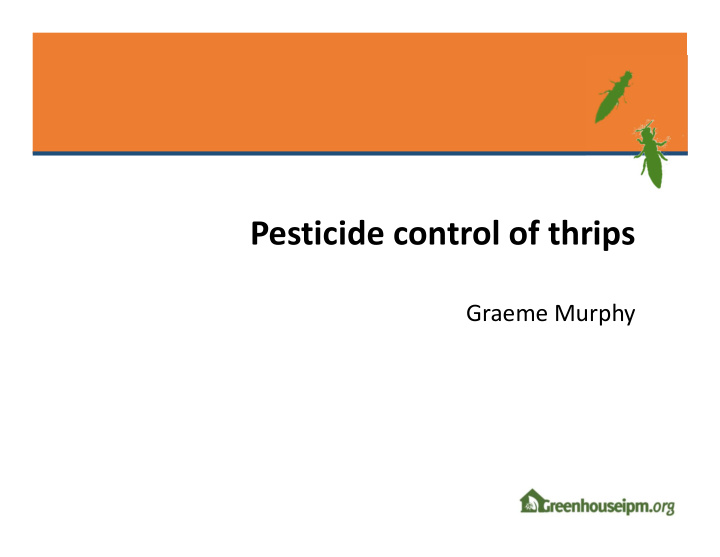



Pesticide control of thrips Graeme Murphy
Pesticide control of thrips… or “Nostalgia ain’t what it used to be” The good old days • An insecticide application every weekend because it was Saturday • Twice a week in summer • Pesticides worked….. most of the time • Against anything that moved • Temik!! LD50 = 5
Fast forward Pesticides registered for thrips control in ornamental greenhouses in 2015, not including microbials • Organophosphates – Orthene, Dursban, Malathion, DDVP (smoke fumigator) • Synthetic pyrethroids – Decis/DeltaGard • Success • Beleaf • Kontos • Pylon • Landscape oil
In reality Pesticides registered for thrips control in ornamental greenhouses in 2015 x x x • Organophosphates – Orthene, Dursban, Malathion, DDVP √ √ ?? x • Synthetic pyrethroids – Decis x • Success • Beleaf √ ?? Poor control of WFT • Kontos √ ? } Phytotoxicity issues, biocontrol All 4 registered within incompatibility, efficacy? the last 2 ‐ 3 years • Pylon √ ? } • Landscape oil cutting dip and foliar spray
Impact of resistance on thrips control Thrips are only a pest because of resistance • Prior to the 1980s, WFT was not a pest in its native range • Pest status likely developed because of pesticide use to control other pests • Spread to all areas of the world on global movement of plant material • In Ontario, one pesticide after another has failed • Finally in 2006, Success (spinosad) was registered
Pesticide resistance: the final straw • Greenhouse Canada, Jan 2006: “SUCCESS 480 SC insecticide should be used in an IPM program and in rotation with other management strategies. A significant concern with this new product is that it will be one of the most effective thrips control products available to growers and great care must be exercised not to over ‐ use it so as to reduce the development of resistance. Resistance of thrips to spinosad has been documented in other areas of the world. It is suggested to use Success for those times when the crop must be clean or when thrips population pressure is greatest. If Success can be used in conjunction with biocontrol options this will also slow the development of resistance. Follow all other precautions and directions for use on the SUCCESS insecticide label.”
Pesticide resistance: the final straw • The failure of Success – the ultimate oxymoron • Within 6 months of being registered, first signs of control failure were seen • Within 12 ‐ 18 months, almost no growers were using it for thrips control • At that time, the only effective option available was DDVP • As a result, 2007 ‐ 2008 saw a massive shift towards biocontrol in the Ontario greenhouse flower industry • Currently ~70% (or more) of Ontario flower growers use biocontrol
So how can we use pesticides in a biocontrol program? • We know what pesticides are available for thrips control • DDVP – highly toxic, very short persistence, has its place in IPM • Landscape oil as a cutting dip for crops such as chrysanthemum • Beleaf, Kontos, Pylon – limitations on all • But what about using pesticides for control of other insects, mites, diseases? • What about PGRs?
Side effects of pesticides • Not all pests have the same arsenal of effective BCAs as we have for thrips • Disease management still relies largely on fungicides • We need to know what the impact may be on our bioprograms of any other products we use • No pesticide is completely safe in all situations and against all BCAs • Side effects lists are available that provide information on potential collateral damage of using pesticides
Side effects lists • http://www.biobestgroup.com/en/side ‐ effect ‐ manual • http://side ‐ effects.koppert.nl/ • http://www.ipmimpact.com/ • Be aware that there can be differences among these lists • These lists are guides only, not a licence or prescription to use • Provide information on acute toxicity only, not sub ‐ lethal effects • 25 ‐ 50% mortality is classed as slightly toxic! • Use pesticides very carefully, ask questions, do your own research
What about PGRs? • Long thought to be harmless to biocontrol programs • Widely used in many ornamental crops • Recent work by Prado and Frank in NC has demonstrated considerable sublethal and lethal effects of PGRs such as Bonzi, Sumagic and A ‐ Rest on A. colemani • Not just directly, but also indirectly • Plant architecture, emergence from mummies, % females, parasitoid size • What about other BCAs?
Uses for pesticides in biocontrol • Clean up after crop (other options may work better) • Clean up prior to starting biocontrol (very carefully) • Where biocontrol is not working?? • Need to understand why it is not working • Will pesticides work any better? • What will be the wider implications? • In situations where pests have few (or no) BCAs available, e.g. secondary pests such as Lygus , leafhoppers, fleahoppers • Quarantine pests • In any situation where pesticides are used, choose wisely and understand the implications
Recommend
More recommend